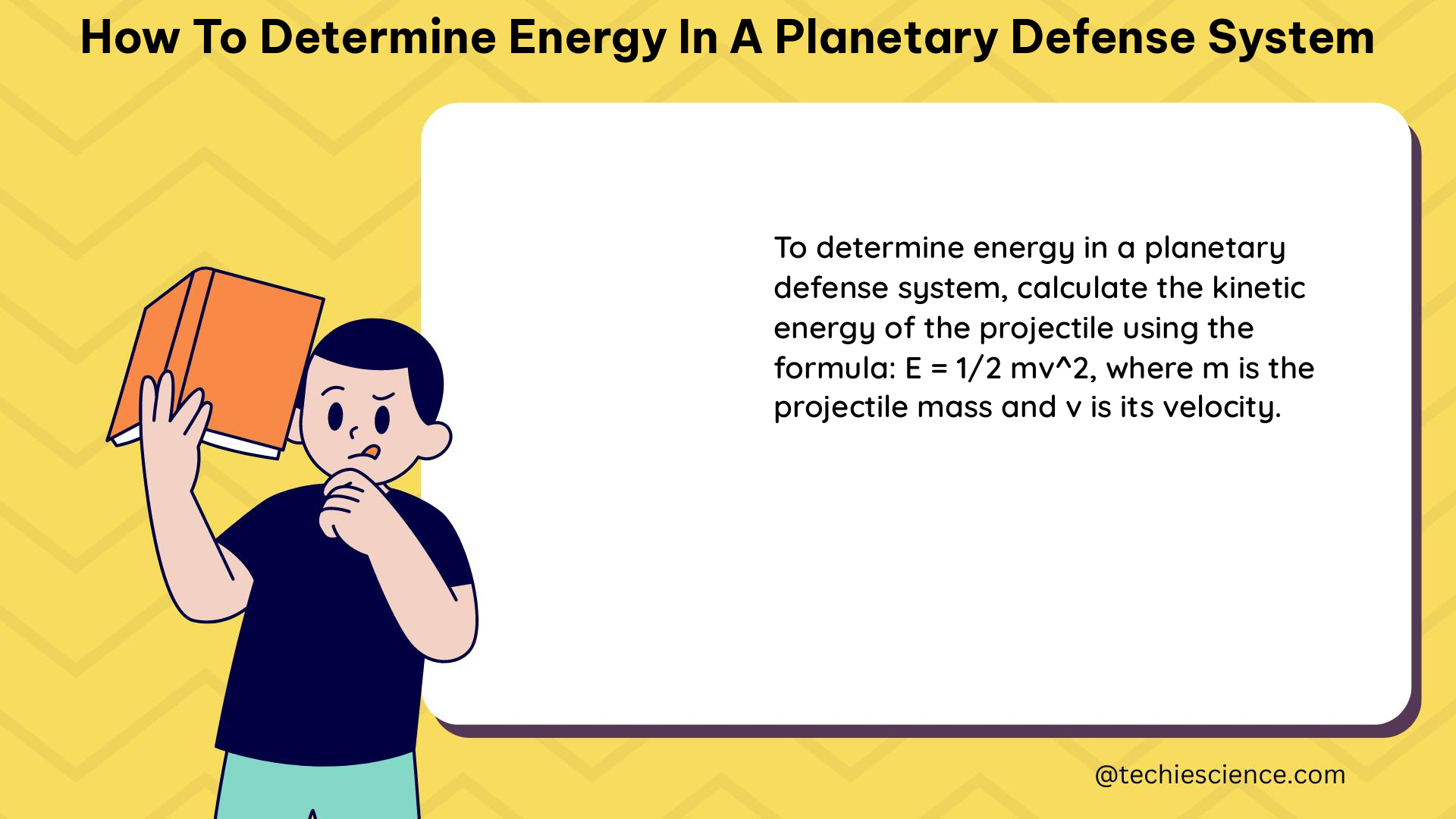Determining the energy in a planetary defense system is crucial for effectively mitigating asteroid threats. This comprehensive guide delves into the key measurable and quantifiable data points that are essential for understanding and optimizing the energy transfer in such systems.
Kinetic Impactor Technique
The kinetic impactor technique is a widely studied approach in planetary defense, where a spacecraft collides with an asteroid to alter its trajectory. To determine the energy involved in this process, several critical parameters must be considered.
Momentum Transfer Efficiency (β)
The momentum transfer efficiency, denoted as β, is a crucial parameter that represents the ratio of the momentum imparted to the asteroid to the momentum of the impactor. This value is essential for evaluating the effectiveness of the kinetic impactor technique. The DART mission, for example, aimed to measure β with an uncertainty of 7.3 seconds or less.
The momentum transfer efficiency can be calculated using the following formula:
β = (Δp_asteroid) / (m_impactor × v_impactor)
Where:
– Δp_asteroid is the change in the asteroid’s momentum
– m_impactor is the mass of the impactor
– v_impactor is the velocity of the impactor
Impact Velocity
The velocity at which the impactor collides with the asteroid is a critical parameter in determining the energy transfer. For the DART mission, the impact velocity was approximately 6.6 km/s.
The kinetic energy of the impactor can be calculated using the formula:
E_kinetic = 1/2 × m_impactor × v_impactor^2
Where:
– E_kinetic is the kinetic energy of the impactor
– m_impactor is the mass of the impactor
– v_impactor is the velocity of the impactor
Change in Orbital Period
The change in the asteroid’s orbital period is a direct result of the momentum transfer during the kinetic impactor event. The DART mission aimed to cause a change of at least 73 seconds in the binary orbit period of Dimorphos.
The change in orbital period can be calculated using Kepler’s third law:
P^2 = k × a^3
Where:
– P is the orbital period of the asteroid
– a is the semi-major axis of the asteroid’s orbit
– k is a constant that depends on the units used
Asteroid Characterization

Accurate characterization of the target asteroid is essential for modeling the impact dynamics and energy transfer.
Mass
The mass of the asteroid is a crucial parameter for modeling the impact and determining the energy transfer. The mass of Dimorphos, the target of the DART mission, was estimated using Kepler’s third law and radar measurements.
The mass of an asteroid can be calculated using the formula:
m_asteroid = (4/3) × π × ρ × r^3
Where:
– m_asteroid is the mass of the asteroid
– ρ is the density of the asteroid
– r is the radius of the asteroid
Shape and Size
The shape and size of the asteroid affect the impact dynamics and energy transfer. The DART mission used imaging data to determine the shape and size of Dimorphos.
Surface Properties
Understanding the surface properties of the asteroid, such as its rotation state and gravitational field, is crucial for safe approach and interaction with the target. These properties can influence the energy transfer during the impact.
Energy Transfer
In addition to the kinetic impactor technique, other approaches focus on energy transfer rather than momentum transfer.
Hypervelocity Kinetic Penetrators
The PI method, proposed by Philip Lubin, involves using an array of small hypervelocity kinetic penetrators to disassemble and fragment asteroids. This approach aims to transfer energy to the asteroid, effectively mitigating threats by pulverizing them and using the Earth’s atmosphere as a shield.
The energy transfer in this method can be calculated using the formula:
E_transfer = 1/2 × m_penetrator × v_penetrator^2 × N
Where:
– E_transfer is the total energy transferred to the asteroid
– m_penetrator is the mass of a single penetrator
– v_penetrator is the velocity of the penetrator
– N is the number of penetrators
Simulation and Modeling
Advanced simulations and modeling are essential for understanding the physics of hypervelocity impacts and optimizing the fragmentation of asteroids.
Impact Simulations
Simulations using codes like the LLNL arbitrary Lagrangian-Eulerian (ALE) hydrodynamics code ALE3D are crucial for modeling the impact dynamics and energy transfer. These simulations help researchers understand the complex processes involved in asteroid deflection and fragmentation.
Modeling Parameters
Parameters such as the asteroid’s strength, damage models, and macro- and microporosity distributions are critical for accurate modeling of the impact and deflection processes. Incorporating these parameters into the simulations allows for more reliable predictions of the energy transfer and the overall effectiveness of the planetary defense system.
By combining the measurable and quantifiable data points discussed in this guide, planetary defense systems can be designed and optimized to effectively mitigate asteroid threats and protect our planet.
References:
- Goals and Objectives for the Exploration and Investigation of the Solar System’s Small Bodies. (2016). Retrieved from https://www.lpi.usra.edu/sbag/goals/SBAG_GoalsDoc_ver.1.2.2016.pdf
- The Double Asteroid Redirection Test (DART): Planetary Defense. (2021). Retrieved from https://iopscience.iop.org/article/10.3847/PSJ/ac063e
- Planetary Defense: Defending Earth Through Applied Planetary Science. (2023). Retrieved from https://nap.nationalacademies.org/read/26522/chapter/20
- Successful kinetic impact into an asteroid for planetary defence. (2023). Retrieved from https://www.nature.com/articles/s41586-023-05810-5
- PI – Planetary Defense – NASA. (2023). Retrieved from https://www.nasa.gov/general/pi-planetary-defense/

The lambdageeks.com Core SME Team is a group of experienced subject matter experts from diverse scientific and technical fields including Physics, Chemistry, Technology,Electronics & Electrical Engineering, Automotive, Mechanical Engineering. Our team collaborates to create high-quality, well-researched articles on a wide range of science and technology topics for the lambdageeks.com website.
All Our Senior SME are having more than 7 Years of experience in the respective fields . They are either Working Industry Professionals or assocaited With different Universities. Refer Our Authors Page to get to know About our Core SMEs.